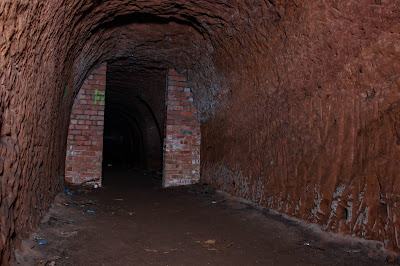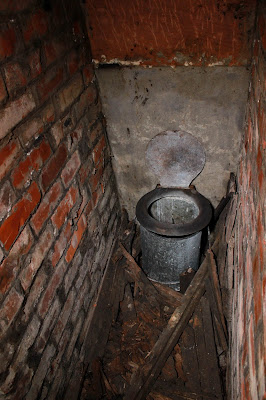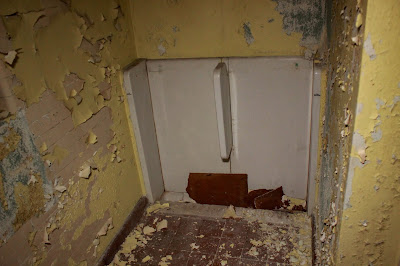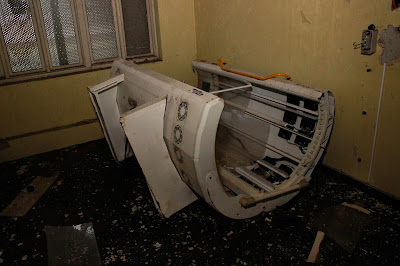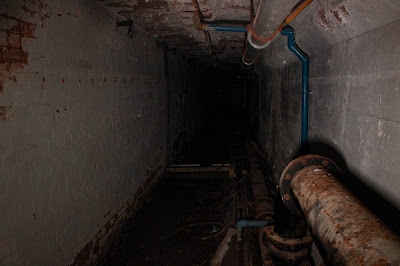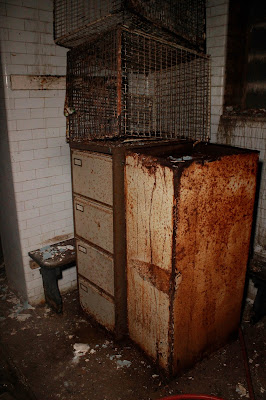Subterranean treasures are always wonderful to find, although seldom ever easy to locate. That's part of the charm- an actual reward for actual effort. Prior to this one getting smeared all over the internet, with directions to it posted in the public domain resulting in a tidal wave of visitors and the authorities sealing it up, I went here with only a vague idea of what I'd find, having learned about its existence from Alice and her partner. Eventually, I spotted what I was after. A tiny hole in a wall, obviously once blocked off, but reopened once again. It would be a squeeze, but getting stuck would be hilarious more so than deadly.
Am I nervous about going in alone? Of course not! All the humans are on the outside.
As soon as I entered, I found myself in a room with two three-tiered bunk beds. The hole through which I crawled was clearly not the main entrance, but even if this chamber had ended with a ladder to the surface only a few feet futher in, I would have been content with this little gem. But it didn't end there. This wasn't a measley little bunker, but an entire subterranean labyrinth. As I ventured further in, different passages led off in different directions, and soon I was quite happily lost.
The tunnels sprawl on, allegedly, for a mile in total. But as someone who does a fair bit of walking, I'm a little sceptical. It felt like a bit more than that.
The tunnels date back to the second world war, when for the first time the ordinary British citizen was in danger in their own home. This resulted in blackouts so that cities couldn't be spotted at night, and also the creation of air raid shelters so that people could hide when the sirens went off. When it came to shelters of this magnitude, the powers-that-be had a bit of debate over it, with some politicians saying it was an overall futile effort. But ultimately the deciding factor was the fact that a lot of terraced property in urban areas couldn't support their own air raid shelters, and the public needed somewhere to go when the bombs dropped.
Preparations for the tunnels began in 1938, and they opened to the public in 1939. According to one source, they only took four months to make, a feat achieved largely thanks to the sandstone being easy to dig through. Another source claims that they took two years to make, but that's an urban explorer and not an "official" source.
This is one of three tunnel networks under the town. Of the other two, one was opened to the public as a museum in the 1990s, while the other was left forgotten, like this one. While the museum one is the largest, "normal" tourism doesn't really do it for me. This is just the smallest of the remaining two, which makes me drool to think of what the last one has to offer. I know where it is, but not the way in. At least, not yet.
But to my increasing delight, some sources say that there are five tunnel networks. It's a contradiction, but one not made impossible when one considers that one source says that there are three "main" shelters, which would indicate that if the remaining two do exist, they aren't as spectacular and possibly didn't get any use at all. And also, there are rumours of a sixth shelter, but that is just a rumour with no official documentation whatsoever. If it's out there, it's lost, waiting to make its future discoverer very happy.
Here's an old lamp on one of the rusty bunks.
As I ventured deeper and deeper into the tunnels, I moved completely at random at first, figuring that the easiest way to memorise the tunnels and to ensure I saw all of them would be to get completely lost, and be forced to figure out how to get back out again. It's a good method, and also very fun.
It was easy to get temporarily lost here too. There are arrows painted on the walls, but they lie. Or at least, they do now. Whatever entrances they once pointed at have long been sealed up. Every turn brought me to an identical tunnel, lined with a row of three-tier bunk beds that ran the entire length, connected head to toe. There was capacity for a whopping two thousand people down here, and the three main tunnel networks combined could save around 9,300 people. Collectively this makes them the largest public air raid shelter in the UK.
But really, despite being the smaller of the shelters, two thousand people is still a lot, and to think about them all crammed down here while the Luftwaffe flew overhead sure is surreal.
In addition to being a labyrinth of beds, the tunnels also had a toilet block, which someone has adorably labeled with spray paint.
It's just a row of brick cubicles.
And the toilets are all chemical toilets, which is pretty much just a bucket with a seat. This means that someone had the unfortunate job of taking them to be emptied after use.
They're still in better condition than the toilets in some pubs and clubs.
Some of the beds look very new and shiny compared to some of the rusty ones, and at first I wondered if maybe the rusty ones had been exposed to the elements more, but the truth is that for some reason some of the beds were galvanised and others weren't. Galvanizing is basically a process to coat metal in zinc in order to prevent rusting. It was used long before the war, which makes it a little odd to me that it was done on the beds so inconsistently. Perhaps it was a cost saving measure.
The tunnel itself is reinforced in this part too, which makes everything look a little more modern, and has also given the local vandals something to scribble on.
"If Aiden reads this, I'm surprised he got through the hole! Nearly as surprised as I am that his mum didn't abort him."
Poor chubby Aiden.
This might sound weird but I didn't spot the racism until after. I wouldn't take a photo of racism because I think it's petty. I was just looking at the graffiti above it dated 2009. That graffiti is over a decade old, and I think that's kinda cool.
Some people have knocked over the beds too for some reason.
To my knowledge, only one actual bombing took place in the city above, and that was in 1940. But one bombing is still enough. There still would have been scares. The sirens still would have gone off when the German planes approached. Just imagine hundreds of people huddled down here together, with the sound of the siren, and planes and bombs overhead, wondering if their homes and businesses would even be standing when they went back to the surface in the morning.
And yet there are urban explorer videos using "Haunted" as clickbait, as if this place needs help to be special or creepy. The history is enough to speak for this place. It doesn't need sensationalising.
Although I am fond of the supernatural. I just think it's called the supernatural for a reason, in that it exceeds what we know to be natural. For something to be considered supernatural it needs to rule out all rational explanations, and if that happened with enough regularity to sustain as many Youtube channels as it does, it would be scientifically observable, and would no longer be considered supernatural. And in any case, why the hell would anyone die and then come down here to haunt?
The tunnels were open to the public but they started to close it on some nights as the war progressed and the likelihood of being bombed died down. They finally closed for good in 1948, and fell into obscurity. Presumably they were re-discovered and re-explored and re-closed numerous times over the years. It's ridiculous and kinda arrogant to assume it's the modern urbex community who has shone a light on them now after nearly a century. Even by the 1960s they would have become the stuff of urban myth. "My dad says there's tunnels under the town." That sort of thing. By the 1980s, it would be the grandparents telling the story. And before the internet, those who ventured in would not be doing so with the intent on publishing photos.
In actual fact the tunnels were surveyed and mapped in 1975, although I didn't get a look at the maps until after I'd been here. The survey eventually led to the opening of the larger nearby tunnel system as a tourist attraction. But the future of this one was simply to be forgotten once again. Graffiti would indicate that it's been accessible as far back as 2009, and in 2013 the tunnels made headlines when two teenagers got lost down here. According to the article, they didn't have torches or phones on them, which seems a tad absurd. Who would venture deep enough to get lost, but not bring a torch or something? Apparently the kids shouted for help until a passer-by heard their voices and called the emergency services. Twenty firefighters showed up, but in the end it was a cop passing the kids a torch through a gap in the wall that saved the day, enabling them to make their own way out.
Then in 2014, the firefighters came back to put out a fire that was started by homeless people.
And then, of course, the modern UK urbex community got their slice of the pie. But if one looks back, this place was actually explored and documented by urban explorers fairly consistently for years, through the same means of entry. So there was a time when urbexers were generally discreet about coming here, so that it could be enjoyed by urban explorers again and again.
And then it was noticed by people naive to a parents-are-siblings extent about what impact posting an exact location on Facebook can have, as well as the even sillier underbelly of urbex who like to upload videos of themselves being cocky with police after being caught, to prove that they're big men. How did it get to this, where being caught is some kind of flex? It happens all the time. Look at the clickbait titles. "We got caught," or "We set off alarms." It's not good urbex. It's the urbex equivalent of saying you purchased a motorcycle and accompanying the annoucement with a picture of the motorcycle as a flaming crumpled mess after a crash.
Unfortunately gems like this cannot exist without discretion. The best urban explorers know this. But with the exact details of how to find this place publically posted online, it attracted a tidal wave of visitors that was about as subtle as the holocaust, and now the way in has been sealed up. It's unfortunate because it's a pretty cool place, and there are good urban explorers who may never get to see it in person now. This is a pretty typical example of why I don't hand out locations.
Interestingly there are a few bricked up parts, and these have been bashed through in some areas, presumably by people who want to see if there's more to offer or if the brickwork is just for structural support. I decided to take a peek and see if there was anything through these gaps.
There's more tunnel, but not much more. It does make me wonder why it was bricked up.
I'm also not sure what this pile of bricks was, but someone sure didn't like it! There would have been wardens posts and tool stores around the shelter, so maybe this is the remnants of one of those.
In the walls are the indents of former electrical wiring where lighting was installed, sadly all long stripped from the tunnels.
And finally, we have the stairway to the surface.
It's still possible to see where the handrail used to be, but why it was ever removed is a mystery.
The entrance at the top is bricked up, but just on the other side of this wall is a nice ordinary street. Perhaps the people living on it know what's down here, but perhaps they don't.
Fortunately while I was happy to get lost, I was also happy to get out, back to fresh air, sunlight, and food.
But to summarise, I love this place. It's a shame that it's now been sealed off, but maybe someday it will be rediscovered and enjoyed once again. Maybe it will be sealed up long enough to fall into local myth but in the internet age that's unlikely. Maybe someday it will even get the same treatment as its larger counterpart and open up as a museum. Maybe not. But it's still cool that it's all still down there, waiting to be found again.
That's all I've got. Next blog will be a cancer research laboratory, and then after that I'll blog about a cute tiny mortuary. Until then, follow me on Instagram, Reddit and Vero... and the less-loved Twatter and Faceboomer where we eagerly wait to see what Zuckerberg will ban me for next.
Thanks for reading!




